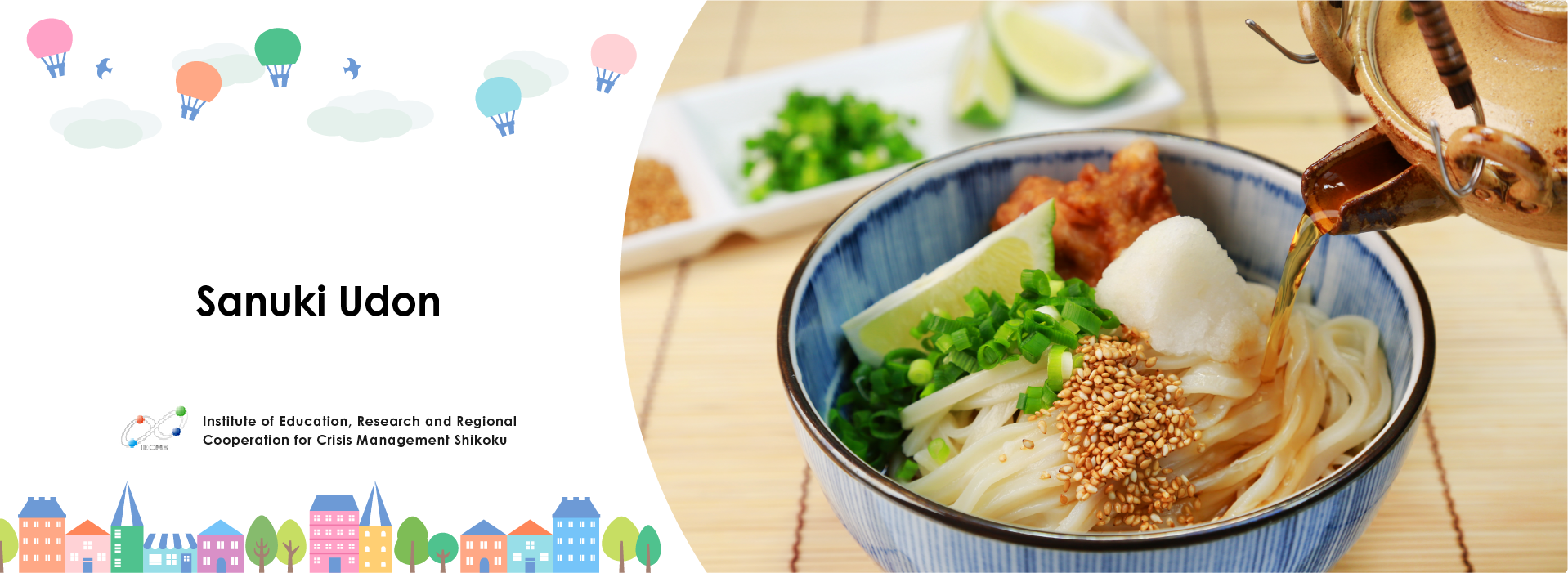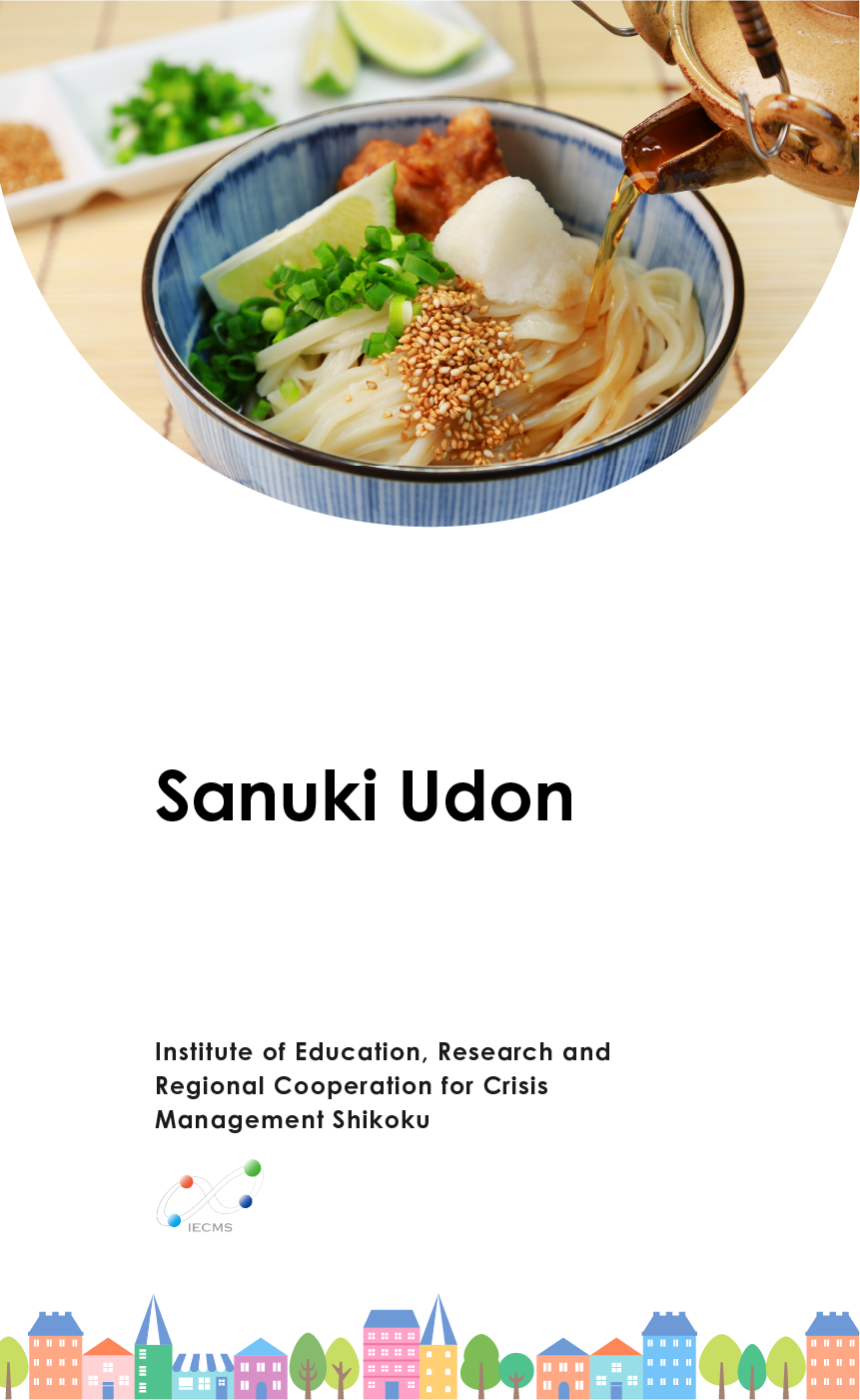




Geo-story of Sanuki Udon Culture

Photo 1 Delicious Sanuki Udon
The staple food of the Japanese people is rice, but the specialty of Kagawa Prefecture is Udon which is known for its unique texture and delicious broth. It is called Sanuki Udon after the old name of Kagawa Prefecture.
Udon is made by kneading wheat flour with salted water, cutting it into long thin strips, boiling them, and pouring soup over them (Photo 1).
Kagawa Prefecture is called "Udon Prefecture" because it has the largest number of udon restaurants in Japan (over 500) and tourists come from all over Japan to try Sanuki udon. However, the delicious Sanuki udon is not available everywhere. The best traditional Sanuki udon restaurants are concentrated in the fan-shaped areas of the Sanuki Plain.

Fig. 1 Topographic Profile of Eastern Shikoku
The reason for the existence of udon culture in the fan-shaped areas of the Sanuki Plain is that the fan-shaped areas are not suitable for rice cultivation due to poor water use but are suitable for wheat cultivation. Moreover, as they are spread out near the coast, the salt needed for making udon, as well as iriko (dried sardines) and soy sauce for soup stock, can be procured from the Seto Inland Sea. (Fig. 1).

Fig. 2 Topography around Kagawa Prefecture
The fan-shaped area and the Seto Inland Sea, which nurtured the Sanuki udon culture, were formed by a direct earthquake caused by the Median Tectonic Line (Fig. 2).
The Sanuki Mountains were uplifted by the 3 million years of faulting of the Median Tectonic Line, and the area with the lowest rainfall in the Seto Inland Sea was formed on the north side of the mountains, creating a fan-shaped area with poor water holding capacity.
The people of Sanuki built irrigation reservoirs to continue rice cultivation on the fan-shaped land and took advantage of the good drainage of the fan to grow wheat in preparation for droughts. The farmers continued to produce udon, which became the soul food of Sanuki.
The 3-million-year-long faulting of the Median Tectonic Line formed the Seto (a rising region with many islands) and Nada (a sinking region with few islands) areas of the Seto Inland Sea, and salt fields developed on the sandy mudflats of the Seto.

Photo 2 Scenic spot of Sanuki Udon
The Shikoku Mountains are the keystone of the Seto Inland Sea climatic zone, which has little rainfall because it blocks rainfall from typhoons in summer and has many sunny days suitable for salt field development. The uplift of the Shikoku Mountains is attributed to volcanic activity 14 million years ago, which formed a large granite body underneath the Shikoku Mountains. At that time, intense Setouchi volcanic activity in the northwestern part of Shikoku formed the prototype of Mt. Iino (Sanuki Fuji) and other mountains. Iino, reservoirs, and udon shops (noodle mills) in Marugamedaira, the original landscape of Sanuki udon, are all related. (Photo 2).
Etiquette at a self-service udon restaurant
It is said that there are roughly 500 to 600 udon restaurants in Kagawa Prefecture. For this reason, Kagawa Prefecture calls itself "Udon Prefecture," and many people in the prefecture are said to take pride in being Udon Prefecture residents. Since you have come to Udon Prefecture, we would like you to try eating authentic Sanuki udon at least once at a restaurant. There are many types of udon restaurants, but here we will introduce the standard etiquette of self-service udon restaurants, from ordering to cleaning up. There are some differences in the details of etiquette between stores, but we hope that you will use your guts and be flexible.
There are many different types of Sanuki udon, but let's try ordering the "Kake Udon," here which is eaten and loved by most of the people in Udon Prefecture.
| ① Ordering area | ・Pick up a tray out of the provided ones and go to the ordering area. ・Order one bowl of Kake Udon. ・Try to say "Kake Sho (small)" like the people of Udon prefecture. |
|---|---|
| ② Dashi area | ・Pour the appropriate amount of soup into your bowl from the special soup stock tank by turning the knob. ・In some restaurants, the staff will pour the soup for you. |
| ③ Tempura area | ・There are many kinds of tempura available, so choose your favorite one. ・If you are curious about the ingredients of the tempura, ask the staff. |
| ④ Condiments area | ・Choose your favorite condiments from green onion, ginger, sesame, and tenkasu. ・It is recommended not to take too much of each. |
| ⑤ Payment area | ・Cash is the basic payment method. There are few self-service udon restaurants that accept electronic money or cards. |
| ⑥ Eating area | ・There are no particular rules other than using chopsticks to eat udon. ・It may sound a little unmannerly, but it is normal to eat udon while making noise. ・Take your time and enjoy the authentic Kake Udon. |
| ⑦ Cleanup area | ・Returning everything to the designated area after eating is also one of the important etiquettes at self-service udon restaurants. |
(Note): The order of items ② through ④ above differs from restaurant to restaurant.
If you are an international student at Kagawa University, you can practice eating udon at the university cafeteria before going to the restaurant to reduce the risk of mistakes. It is also a good idea to take a Japanese friend along when you go to the restaurant so that you can feel safe and avoid making a big mistake.
Institute of Education, Research and Regional Cooperation for Crisis Management Shikoku
Copyright(C) 2022 Kagawa University All Rights Reserved.